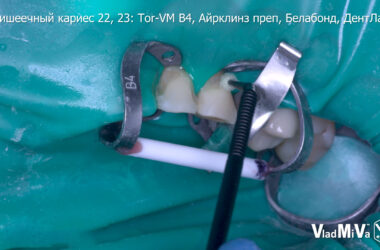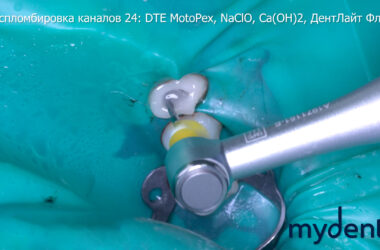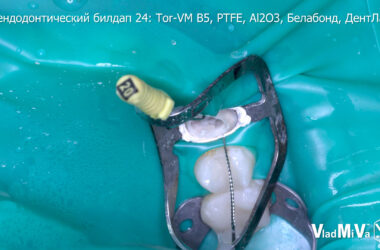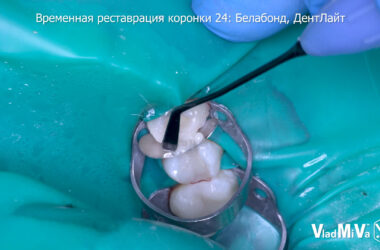ПАСКАЛЬ МАНЬЕ, доктор медицинских наук, доктор философии. Стажный доцент, директор отделения эстетической стоматологии, отделение первичной гигиены полости рта, университет Школы стоматологии Южной Калифорнии, Лос-Анджелес, Калифорния, США
АБСТРАКТ
Цель этой статьи — рассмотреть научно обоснованные принципы, которые могут помочь оптимизировать адгезию к дентину при непрямых композитных и фарфоровых реставрациях. Было рассмотрено более 30 статей, большинство из которых посвящены конкретной ситуации с бондингом к дентину при непрямых реставрациях. Похоже, что совокупные результаты этих данных плюс клинический опыт указывают на необходимость пересмотра процедуры бондинга дентина. Рекомендуется немедленное нанесение и полимеризация дентинного связующего агента на свежесрезанный дентин перед снятием оттиска. Эта новая процедура нанесения, так называемая немедленная герметизация дентина (IDS), по-видимому, обеспечивает улучшенную прочность соединения, меньшее образование щелей, уменьшение бактериальной утечки и снижение чувствительности дентина.
Использование наполненных адгезивных смол (прокладка с низким модулем упругости) облегчает клинические и технические аспекты IDS. Этот рациональный подход к адгезии также оказывает положительное влияние на сохранение структуры зуба, комфорт пациента и долгосрочную выживаемость реставраций с непрямой адгезией.
КЛИНИЧЕСКОЕ ЗНАЧЕНИЕ
Подготовка зубов к непрямым реставрациям (например, композитным/керамическим вкладкам, накладкам и винирам) может привести к значительному обнажению дентина. Рекомендуется герметизировать эти свежесрезанные поверхности дентина дентиновым связующим веществом (DBA) сразу после препарирования зуба и перед снятием слепка. Для этой конкретной цели рекомендуется трехэтапное тотальное протравливание DBA с наполненной адгезивной смолой. Подробно представлены основные преимущества, а также технические проблемы этой процедуры.
(JOURNAL OF ESTHETIC AND RESTORATIVE DENTISTRY 17:144–155, 2005)
Список литературных инсточников
- Nakabayashi N, Kojima K, Masuhara E. The promotion of adhesion by the infiltration of monomers into tooth substrates. J Biomed Mater Res 1982; 16:265–273.
- Nakabayashi N, Nakamura M, Yasuda N. Hybrid layer as a dentin-bonding mechanism. J Esthet Dent 1991; 3:133–138.
- Lin CP, Douglas WH. Structure-property relations and crack resistance at the bovine dentin-enamel junction. J Dent Res 1994; 73:1072–1078.
- Lin CP, Douglas WH, Erlandsen SL. Scanning electron microscopy of type I collagen at the dentin-enamel junction of human teeth. J Histochem Cytochem 1993; 41:381–388.
- Magne P, Belser U. Understanding the intact tooth and the biomimetic principle. In: Magne P, Belser U, eds. Bonded porcelain restorations in the anterior dentition—a biomimetic approach. Chicago: Quintessence Publishing Co., 2002:23–55.
- Magne P, Douglas WH. Rationalization of esthetic restorative dentistry based on biomimetics. J Esthet Dent 1999; 11:5–15.
- Dumfahrt H. Porcelain laminate veneers. A retrospective evaluation after 1 to 10 years of service: part II—clinical results. Int J Prosthodont 2000; 13:9–18.
- Friedman MJ. A 15-year review of porcelain veneer failure—a clinician’s observations. Compend Contin Educ Dent 1998; 19:625–628.
- Magne P, Belser U. Immediate dentin bonding. In: Magne P, Belser U, eds. Bonded porcelain restorations in the anterior dentition—a biomimetic approach. Chicago: Quintessence Publishing Co., 2002:270–273, 358–363.
- Bertshinger C, Paul SJ, Luthy H, Schaerer P. Dual application of dentin bonding
agents: its effect on the bond strength. Am J Dent 1996; 9:115–119. - Paul SJ, Schaerer P. Effect of provisional cements on the bond strength of various adhesive bonding systems on dentine. J Oral Rehabil 1997; 24:8–14.
- Paul SJ, Schaerer P. The dual bonding technique: a modified method to improve adhesive luting procedures. Int J Periodontics Restorative Dent 1997; 17:536–545.
- McCabe JF, Rusby S. Dentine bonding—the effect of pre-curing the bonding resin. Br Dent J 1994; 176:333–336.
- Frankenberger R, Sindel J, Kramer N, Petschelt A. Dentin bond strength and marginal adaptation: direct composite resins vs ceramic inlays. Oper Dent 1999; 24:147–155.
- Dietschi D, Magne P, Holz J. Bonded to tooth ceramic restorations: in vitro evaluation of the efficiency and failure mode of two modern adhesives. Schweiz Monatsschr Zahnmed 1995; 105:299–305.
- Magne P, Douglas WH. Porcelain veneers: dentin bonding optimization and biomimetic
recovery of the crown. Int J Prosthodont 1999; 12:111–121. - Dietshi D, Hertzfeld D. In-vitro evaluation of marginal and internal adaptation of
Class II resin composite restorations after thermal and occlusal stressing. Eur J Oral Sci 1998; 106:1033–1042. - Tay FR, Gwinnett AJ, Pang KM, Wei SH. Variability in microleakage observed in a total-etch wet-bonding technique under different handling conditions. J Dent Res 1995; 74:1168–1178.
- Pashley EL, Comer RW, Simpson MD, Horner JA, Pashley DH, Caughman WF. Dentin permeability: sealing the dentin in crown preparations. Oper Dent 1992; 17:13–20.
- Paul SJ, Scharer P. Factors in dentin bonding. Part II: a review of the morphology and physiology of human dentin. J Esthet Dent 1993; 5:51–54.
- Paul SJ, Scharer P. Intrapulpal pressure and thermal cycling: effect on shear bond strength of eleven modern dentin bonding agents. J Esthet Dent 1993; 5:179–185.
- Rueggeberg FA, Margeson DH. The effect of oxygen inhibition on an unfilled/filled
composite system. J Dent Res 1990; 69:1652–1658. - Ozturk N, Aykent F. Dentin bond strengths of two ceramic inlay systems after cementation with three different techniques and one bonding system. J Prosthet Dent 2003; 89:275–281.
- Jayasooriya PR, Pereira PN, Nikaido T, Tagami J. Efficacy of a resin coating on
bond strengths of resin cement to dentin. J Esthet Restor Dent 2003; 15:105–113. - Jayasooriya PR, Pereira PN, Nikaido T, Burrow MF, Tagami J. The effect of a “resin coating” on the interfacial adaptation of composite inlays. Oper Dent 2003; 28:28–35.
- Reis A, Rocha de Oliveira Carrilho M, Schroeder M, Tancredo LL, Dourado Loguercio A. The influence of storage time and cutting speed on microtensile bond strength. J Adhes Dent 2004; 6:7–11.
- Dietschi D, Monasevic M, Krejci I, Davidson C. Marginal and internal adaptation
of Class II restorations after immediate or delayed composite placement. J Dent 2002; 30:259–269. - Cagidiaco MC, Ferrari M, Garberoglio R, Davidson CL. Dentin contamination protection
after mechanical preparation for veneering. Am J Dent 1996; 9:57–60. - Johnson GH, Hazelton LR, Bales DJ, Lepe X. The effect of a resin-based sealer on crown retention for three types of cement. J Prosthet Dent 2004; 91:428–435.
- Magne P, Perroud R, Hodges JS, Belser UC. Clinical performance of novel-design porcelain veneers for the recovery of coronal volume and length. Int J Periodontics Restorative Dent 2000; 20:440–457.
- Darr AH, Jacobsen PH. Conversion of dual cure luting cements. J Oral Rehabil 1995; 22:43–47.
- Magne P, Kwon KR, Belser UC, Hodges JS, Douglas WH. Crack propensity of porcelain laminate veneers: a simulated operatory evaluation. J Prosthet Dent 1999; 81:327–334.
- Magne P, Versluis A, Douglas WH. Effect of luting composite shrinkage and thermal loads on the stress distribution in porcelain laminate veneers. J Prosthet Dent 1999; 81:335–344.
- Van Meerbeek B, De Munck J, Yoshida Y, et al. Buonocore memorial lecture. Adhesion to enamel and dentin: current status and future challenges. Oper Dent 2003; 28:215–235.
- De Munck J, Van Meerbeek B, Satoshi I, et al. Microtensile bond strengths of oneand two-step self-etch adhesives to bur-cut enamel and dentin. Am J Dent 2003; 16:414–420.
- Ferrari M, Tay FR. Technique sensitivity in bonding to vital, acid-etched dentin. Oper Dent 2003; 28:3–8.
- Burrow MF, Inokoshi S, Tagami J. Water sorption of several bonding resins. Am J Dent 1999; 12:295–298.
- Dietschi D, Olsburgh S, Krejci I, Davidson C. In vitro evaluation of marginal and internal adaptation after occlusal stressing of indirect Class II composite restorations with different resinous bases. Eur J Oral Sci 2003; 111:73–80.
- Frankenberger R, Lopes M, Perdigao J, Ambrose WW, Rosa BT. The use of flowable composites as filled adhesives. Dent Mater 2002; 18:227–238.
Запрос на перепечатку: Паскаль Магне, доктор медицинских наук, доктор философии, Университет Южной Калифорнии, Отдел первичной гигиены полости рта,
925 West 34th Street, DEN 4366, Лос-Анджелес, Калифорния, США 90089-0641; электронная почта: magne@usc.edu
©2005 BC Decker Inc.




